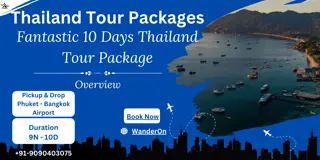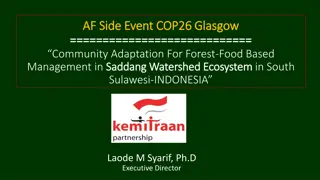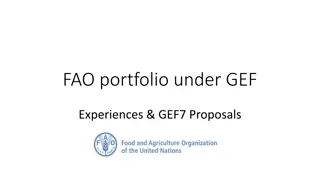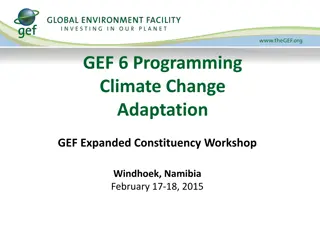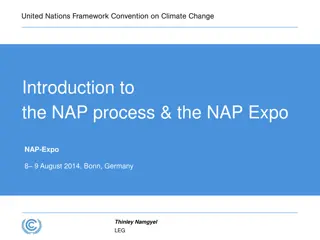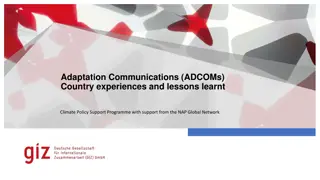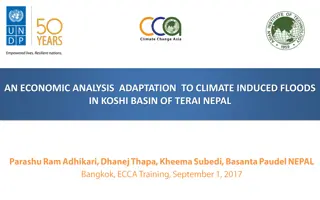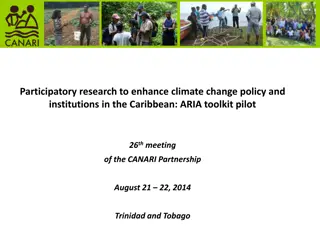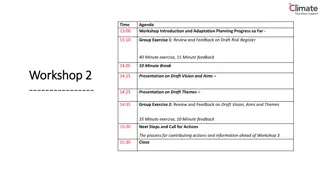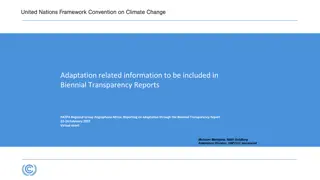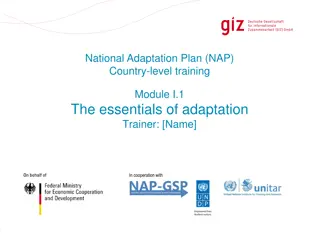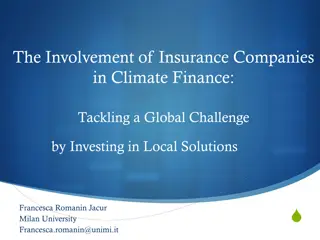Thailand National Adaptation Plan for Climate Resilience
Thailand's National Adaptation Plan focuses on building resilience to climate change impacts through strategic frameworks, guidelines, and financial allocation. It aims to integrate climate adaptation measures across sectors like water management, agriculture, tourism, public health, natural resources, and human settlements. The plan emphasizes long-term strategies, capacity building, and awareness to enhance readiness for climate-related challenges and disasters, promoting sustainable growth and stability.
Download Presentation

Please find below an Image/Link to download the presentation.
The content on the website is provided AS IS for your information and personal use only. It may not be sold, licensed, or shared on other websites without obtaining consent from the author. Download presentation by click this link. If you encounter any issues during the download, it is possible that the publisher has removed the file from their server.
E N D
Presentation Transcript
Extreme Weather Events Sea Level Rise Disaster Drought The 1stDraft of Thailand National Adaptation Plan
1. To provide government agencies and other related entities at the national and local levels with implementation framework, good practices, approaches, and guidelines for developing their own strategies, management plans, and action plans suitable for individual sectors and areas 2. To provide financial agencies with budget allocation framework 3. To lay a strong foundation and develop climate resilient approaches and readiness for the people to be able to adapt to climate change
Thailand will be resilient to climate change impacts and has integrated adaptation measures to increase opportunities and capacities for the country to grow in a stable and sustainable way Duration: Long-term plan (5-Year Revision) Vision: Mission: 1. develop database, research, knowledge, and technology for supporting climate adaptation actions 2. enhance capacities and awareness of development parties at all levels to ensure readiness for conducting the measures in accordance with climate change plans and policies 3. establish and incorporate climate resilience into the national development by promoting the integration of climate adaptation measures in all sectors and at all levels 3
1. Flood & drought and water management 2. Agriculture and food security 3. Tourism 4. Public health 5. Natural resource management 6. Human settlement and security 15/09/67 4
sectors Goals Water Management 1. Balanced management between water supply and water usage of all river basins 2. Resilience and readiness for coping with and reducing damages from floods and droughts 1. Resilience and readiness for tackling natural disasters in agricultural sector 2. Food security at all levels 1. Development and promotion of ecological and sustainable tourisms for travelling options that help reduce climate 2. Adaptive capacity to reducing disaster and climate risks 1. Surveillance mechanism and climate-related disease prevention 2. Capacity building about public health system to address climate change 1. Abundance preservation of natural resources and ecosystem on land 2. Sustainable management of marine and coastal resources 1. Reduction of risks and damages caused by natural disasters to settlement areas 2. Communities prepared for adapting to climate change Agriculture and Food Security Tourism Management Public Health Management Natural resources Management Human Settlement and Security
integrated and balanced water management in river basin systems creation of readiness for tackling and reducing damages caused by droughts and floods Water management Agriculture and food security creation of resilience and readiness for adapting and addressing natural disaster risks maintaining of food security development of agricultural technology for economic value addition development and promotion of ecological and sustainable tourism adaptive capacity to mitigate risks from disasters and climate change Tourism management Public health management The development of surveillance mechanism and climate-related disease prevention The development of public health system capacity and the promotion of the public's accessibility to quality public health services Natural resource management preservation and restoration of natural resources and land ecosystem management of marine and coastal resources Human settlement and security reduction of natural disaster risks and damages creation of readiness and adaptive capacity of the communities
Strategy 1: Water Management Work plan 1.1: The integrated and balanced water management in river basin systems formulate/improve database system regrading the amount of water supply and water demand in all sectors Assess/foresee the impacts on water quantity and the possibility of changes in water flow and the distribution of water sources Promote/support the participatory process in determining water management plans and policies with climate change taken into account manage the Choa Phraya river basin Work plan 1.2: The creation of readiness for tackling and reducing damages caused by droughts and floods restore catchment forest areas to help slow down water flow and increase water absorption provide additional water supply and develop water diversion projects as well as water grid formulate master plan on water resources infrastructure to promote conjunctive use develop drought and flood solutions by adding water into groundwater sources 15/09/67 7
Strategy 2: Agriculture and food security Work plan 2.1: The creation of resilience and readiness for adapting and addressing natural disaster risks manage cultivation zoning map agricultural risk areas to be disseminated to farmers improve and develop agricultural early warning establish the network of surveillance and monitoring climate change impacts Work plan 2.2: The maintaining of food security protect the areas suitable for agriculture together with infrastructure investment develop and support the prevention and the coping with natural disasters impacted on agriculture support new theory agriculture in parallel with environmentally-friendly agriculture develop research and knowledge on biotechnology and genetic bank Work plan 2.3: The development of agricultural technology for economic value addition develop and promote organic farming products leverage processed agricultural industries with the use of innovation and technology to boost 15/09/67 efficiency 8
Strategy 3: Tourism management Work plan 3.1: The development and promotion of ecological and sustainable tourism promote ecological, cultural, and sustainable tourism promote environmentally-friendly management and activities develop tourist modalities with regard to changing climate-concerned infrastructures and facilities build capacities of local administrations, tourist businesspeople, and communities about on ecotourism and sustainability attach importance to sustainable marketing Work plan 3.2: The adaptive capacity to mitigate risks from disasters and climate change devise local standard tourist development plans devise suitable tourist development plans which include the evaluation of water usage efficiency develop early warning systems and evacuation plans 15/09/67 9
Strategy 4: Public health management Work plan 4.1: The development of surveillance mechanism and climate- related disease prevention develop the network of early warning and surveillance in risk areas and population improve health insurance systems to cover climate-risk/vulnerable population develop prototype communities in risk areas Work plan 4.2: The development of public health system capacity and the promotion of the public's accessibility to quality public health services promote the roles and the capacities of public health personnel at all levels to address climate change in a proactive manner develop climate-related health database and information technology at national level develop collaborative mechanism in all sectors both within and without the public health circle 15/09/67 10
Strategy 5: Natural resource management Work plan 5.1: The preservation and restoration of natural resources and land ecosystem preserve and protect conserved forest areas conserve and restore catchment forest areas that are degraded and invaded in order to create a balance on ecosystem in the catchment areas conserve high-biodiversity forest areas promote and bolster reforestation to augment forest areas promote and develop eco-villages Work plan 5.2: The management of marine and coastal resources protect coastal areas by reforestation to increase mangroves conserve and accelerate the restoration of marine and coastal resources to maintain ecosystem balance monitor, control, and crackdown to reduce deforestation enhance knowledge of public network, communities, local administrations to help restore coastal areas with use of natural systems 15/09/67 11
Strategy 6: Human settlement and security Work plan 6.1: The reduction of natural disaster risks and damages study and review the feasibility of the enforcement and the development of specific city plans in climate risk areas for long-term solutions develop the infrastructures necessary for coping with emergencies as the result of natural disasters establish flood and landslide early warning prevent floods in urban areas and resolve floods in specific areas as requested by locals Work plan 6.2: The creation of readiness and adaptive capacity of the communities survey and check existing infrastructures and buildings that hamper water runoff in order to analyze, redesign, and restructure them support and promote the coping capacities of local administrations to be prepared for floods along rivers and tributaries promote locals to initiate adaptation plans, together with the determination of vision and urban development strategies 12
Preparation Approach for the Implementation of National Adaptation Plan The readiness and capacity building of all stakeholders involved in the country The development of database, knowledge, and research to support the implementation and the monitoring The promotion of integrated and collaborative implementation across relevant agencies and sectors The institution rearrangement, the public management system, the development of supporting mechanisms, and the budget allocation 15/09/67 13
Thank You Policy and Strategy Section ClimateChangeCoordinationandManagementDivision OfficeofNaturalResourcesandEnvironmentalPolicyandPlanning RamaVIRd., PhayathaiDistrict, Bangkok 10400 Thailand T/F: +66 2265 6692, +66 2265 6500 ext. 6842 climate.onep.go.th 15/09/67 14





